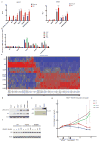ESR1 ligand-binding domain mutations in hormone-resistant breast cancer
- PMID: 24185512
- PMCID: PMC3903423
- DOI: 10.1038/ng.2822
ESR1 ligand-binding domain mutations in hormone-resistant breast cancer
Abstract
Seventy percent of breast cancers express estrogen receptor (ER), and most of these are sensitive to ER inhibition. However, many such tumors for unknown reasons become refractory to inhibition of estrogen action in the metastatic setting. We conducted a comprehensive genetic analysis of two independent cohorts of metastatic ER-positive breast tumors and identified mutations in ESR1 affecting the ligand-binding domain (LBD) in 14 of 80 cases. These included highly recurrent mutations encoding p.Tyr537Ser, p.Tyr537Asn and p.Asp538Gly alterations. Molecular dynamics simulations suggest that the structures of the Tyr537Ser and Asp538Gly mutants involve hydrogen bonding of the mutant amino acids with Asp351, thus favoring the agonist conformation of the receptor. Consistent with this model, mutant receptors drive ER-dependent transcription and proliferation in the absence of hormone and reduce the efficacy of ER antagonists. These data implicate LBD-mutant forms of ER in mediating clinical resistance to hormonal therapy and suggest that more potent ER antagonists may be of substantial therapeutic benefit.
Conflict of interest statement
The authors declare no competing financial interests.
Figures




Comment in
-
The search for ESR1 mutations in breast cancer.Nat Genet. 2013 Dec;45(12):1415-6. doi: 10.1038/ng.2831. Nat Genet. 2013. PMID: 24270445 Free PMC article.
-
Drug resistance: making a point.Nat Rev Cancer. 2014 Jan;14(1):6. doi: 10.1038/nrc3649. Epub 2013 Nov 28. Nat Rev Cancer. 2014. PMID: 24285243 No abstract available.
References
-
- Effects of chemotherapy and hormonal therapy for early breast cancer on recurrence and 15-year survival: an overview of the randomised trials. Lancet. 2005;365:1687–717. - PubMed
-
- Ariazi EA, Ariazi JL, Cordera F, Jordan VC. Estrogen receptors as therapeutic targets in breast cancer. Curr Top Med Chem. 2006;6:181–202. - PubMed
-
- Strasser-Weippl K, Goss PE. Advances in adjuvant hormonal therapy for postmenopausal women. J Clin Oncol. 2005;23:1751–9. - PubMed
-
- Forbes JF, et al. Effect of anastrozole and tamoxifen as adjuvant treatment for early-stage breast cancer: 100-month analysis of the ATAC trial. Lancet Oncol. 2008;9:45–53. - PubMed
Publication types
MeSH terms
Substances
Associated data
- Actions
Grants and funding
LinkOut - more resources
Full Text Sources
Other Literature Sources
Medical
Molecular Biology Databases
Research Materials
Miscellaneous

